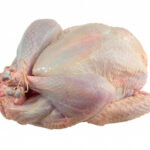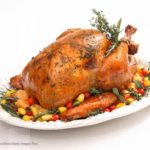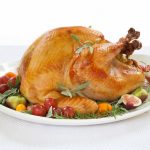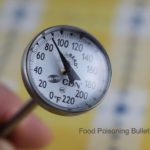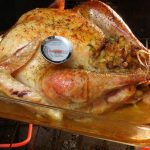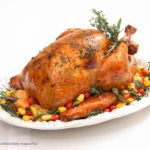A new CDC study has revealed the Salmonella serotypes most commonly linked to Thanksgiving foods such as turkey. The study used routine surveillance for the years 1998 to 2018, and a case-crossover design. In 2017, there were about 45,000,000 turkeys produced for Thanksgiving. About 88% of consumers in the United States report that they eat turkey during the Thanksgiving meal. There are about 1 million cases of Salmonella reported in the United States every year. These illnesses cause 20,000 hospitalizations and 400 deaths annually. Since a small percentage of people infected with this pathogen actually seek medical help every year, the number is likely much higher. Salmonella Hadar and Saint Paul are the serotypes that are most commonly associated with turkey. The serotypes … [Read more...]
Keep Thanksgiving Leftovers Safe With Tips From the USDA
It's Thanksgiving. One of the best parts of this holiday is leftovers. So you should know how to keep Thanksgiving leftovers safe with these tips from the USDA. When you take foods out of the oven or refrigerator, set a timer and follow the two hour rule. That means that all perishable items such as the turkey, stuffing, side dishes, and desserts should be refrigerated within two hours after coming out of those appliances. After two hours, these foods enter the "danger zone" between 40°F and 140°F, where bacteria can double every 20 minutes. Then, even if you thoroughly reheat those foods, the bacteria could have produced toxins that are not destroyed by heat and can still make you sick. When you break down the foods from the meal, put them into shallow containers so they cool … [Read more...]
Prepare Your Holiday Turkey Safely with Tips From the CDC
It's almost Thanksgiving! Prepare your holiday turkey safely with tips from the Centers for Disease Control and Prevention (CDC). Since turkey can be contaminated with Salmonella bacteria, it must be handled carefully. First of all, store the turkey properly. It should be stored in the freezer until you are ready to thaw it. Do not store a turkey in a car trunk, in snow, or on the back porch. At this point it's too late to properly thaw a large frozen turkey in the fridge, but you can cook it from the frozen state. It takes 24 hours of thawing in the refrigerator for each four to five pounds of turkey. Never ever thaw a turkey or any meat on the counter. The meat will remain in the danger zone of 40°F to 140°F too long, and bacteria will multiply. At room temperature, bacterial … [Read more...]
Keep Thanksgiving Leftovers Safe With Tips From the USDA
Happy Thanksgiving! Keep Thanksgiving leftovers safe with tips from the USDA. Since the meal for this holiday is usually quite large, you will most likely have lots of leftovers, which must be stored properly to prevent food poisoning. The temperature danger zone for perishable foods is 40°F to 140°F. In that range, bacteria in foods can double every 20 minutes. First, remember the two hour rule. All perishable foods must be refrigerated within two hours of coming out of the oven or out of the fridge for serving. This time decreases to one hour if the ambient air temperature is above 90°F. To make sure that food cools down quickly and gets through the danger zone fast, divide food into smaller amounts and package in shallow containers. When you have stored the food in the … [Read more...]
Follow Thanksgiving Food Safety Steps from the CDC For a Safe Holiday
The CDC is offering Thanksgiving food safety steps for you to follow as you prepare this holiday dinner to stay safe. This Thanksgiving will be different, with fewer large gatherings and more people staying home to protect themselves against Covid-19. So avoid food poisoning, which is a major risk during the pandemic, with these tips. First, keep it clean. Always wash your hands with soap and water before you start to cook and eat. Make sure that food preparing surfaces and utensils are clean and sanitized before you start to cook. Think about sanitizing the sink and countertops before you bring out the food. You can use a commercial product or make your own by mixing 1 tablespoon liquid chlorine bleach with one gallon of warm water. For meal prep, make sure that you keep raw … [Read more...]
Keep Your Thanksgiving Turkey Safe With Tips From CDC
The Centers for Disease Control and Prevention is offering tips to keep your Thanksgiving meal safe, concentrating on the turkey. Turkey and other poultry are often contaminated with bacteria and require special handling. Keep your Thanksgiving turkey safe with these tips. In fact, a report in the Center for Disease Control and Prevention's (CDC) Morbidity and Mortality Weekly Report for the week of November 22, 2019 states that during a huge Salmonella Reading outbreak last year, "“Evidence demonstrated that the outbreak strain was present throughout the turkey industry in live turkeys and in raw turkey products meant for human and animal consumption." When you buy your turkey, put it into the grocery cart last, go right home, and put it in the refrigerator promptly. If you are … [Read more...]
Salmonella Turkey is Still a Problem, With Thanksgiving Approaching
Salmonella turkey is still a problem with the Thanksgiving holiday approaching, according to a report in the CDC's Morbidity and Mortality Report (MMWR) for the week of November 22, 2019. Last year, a huge turkey recall linked to a Salmonella outbreak hit the U.S. just before Thanksgiving. And the problem hasn't gone away, according to government officials. A multistate outbreak of Salmonella Reading food poisoning cases occurred from November 17 through March 2019. A total of 356 people in 42 states were sickened. What's noteworthy is that the MMWR report states that "cases continue to be identified." What Types of Turkey are the Problem? The patients told investigators they were exposed to various turkey products and live turkeys, suggesting that this issue is endemic in the … [Read more...]
Thanksgiving Food Safety Tips To Keep Your Family Safe
Thanksgiving is a wonderful holiday in the U.S. But the food associated with this holiday, especially the turkey and stuffing, aren't commonly made by most consumers, so there are food safety risks. Foodsafety.gov is offering help with Thanksgiving food safety tips. Safe turkey handling is especially important this year, with the CDC notice of a deadly Salmonella Reading outbreak that has sickened 160 people, hospitalized 93, and killed one person in California. Officials have named some types of Jennie-O ground raw turkey in association with this outbreak, and recalled those products, but have not identified any more brands or producers of turkey. That means it's up to the consumer to make sure the turkey is safely and properly prepared. These Thanksgiving food safety tips will … [Read more...]
Thanksgiving Turkey Food Safety Tips From the CDC
The Centers for Disease Control and Prevention is offering Thanksgiving turkey food safety tips, especially about your holiday turkey. This year, a multistate outbreak of Salmonella Reading has sickened at least 164 people in 35 states, hospitalized 63 of those patients, and killed one person in California. The statement says, "Food handling errors and inadequate cooing are the most common problems that lead to poultry-associated foodborne disease outbreaks in the United States." You need to know that most poultry products sold in this country are contaminated with pathogenic bacteria. For instance, Consumer Reports found that 97% of the chicken breasts they purchased were contaminated. So it's up to the consumer to protect himself. Here are the Thanksgiving food safety steps you … [Read more...]
Thanksgiving Leftovers: How to Handle Them so You Don’t Get Sick
The USDA is offering tips on how to handle Thanksgiving leftovers so you and your family don't get sick. It is now four days after Thanksgiving, which means that today is the day all of the leftover food from that holiday should be either eaten or frozen for food safety reasons. First, remember to keep food out of the danger zone of 40°F to 140°F. That's the temperature range where bacteria grow most rapidly. All of your Thanksgiving food should have been refrigerated within two hours of finishing cooking or being taken out of the fridge. All of the food should be cooled quickly. Never put the whole turkey back into the fridge, since it can take a long to cool to a safe temperature. Cut the turkey into pieces, slice the breast, and place the meat into shallow … [Read more...]
